Technology
-
 Science and Technology Policy Professor Chihyung Jeon Awarded Rachel Carson Fellowship
KAIST Graduate School of Science and Technology Policy Professor Chihyung Jeon has been awarded the Rachel Carson Fellowship 2015-2016.
Rachel Carson Center for Environment and Society is a research center for environmental humanities and social sciences, supported by the German Federal Ministry of Education and Research. It was founded by Ludwig-Maximilians-Universität, Munich, Germany and the Deutsches Museum as a joint initiative in 2009.
Rachel Carson Center supports researches in humanities and social sciences on the interactions between the environment and the society, following the footsteps of Rachel Cason, who raised awareness on the chemical environmental damage and started global environmental movement through her published book “Silent Spring” in 1962.
The center is awarding Rachel Carson Fellowships to established researchers to fund their writing and promote exchange of research. This year, 31 fellowships were awarded.
Professor Jeon will conduct research on "A Dredged Nation: The Four Rivers Restoration Project and the Envirotechnical Transformation of South Korea" and will also hold an additional post of International Curatorial Fellow at the Deutsches Museum.
2015.06.11 View 11504
Science and Technology Policy Professor Chihyung Jeon Awarded Rachel Carson Fellowship
KAIST Graduate School of Science and Technology Policy Professor Chihyung Jeon has been awarded the Rachel Carson Fellowship 2015-2016.
Rachel Carson Center for Environment and Society is a research center for environmental humanities and social sciences, supported by the German Federal Ministry of Education and Research. It was founded by Ludwig-Maximilians-Universität, Munich, Germany and the Deutsches Museum as a joint initiative in 2009.
Rachel Carson Center supports researches in humanities and social sciences on the interactions between the environment and the society, following the footsteps of Rachel Cason, who raised awareness on the chemical environmental damage and started global environmental movement through her published book “Silent Spring” in 1962.
The center is awarding Rachel Carson Fellowships to established researchers to fund their writing and promote exchange of research. This year, 31 fellowships were awarded.
Professor Jeon will conduct research on "A Dredged Nation: The Four Rivers Restoration Project and the Envirotechnical Transformation of South Korea" and will also hold an additional post of International Curatorial Fellow at the Deutsches Museum.
2015.06.11 View 11504 -
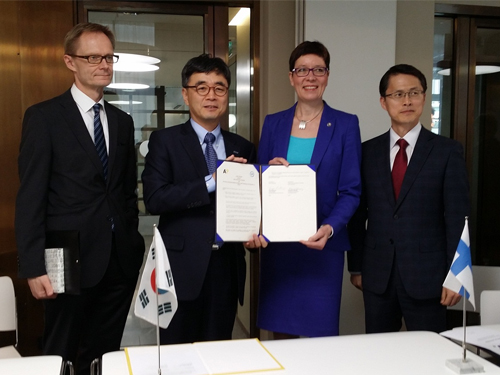 KAIST to Kick-Start the Exchange of Young Researchers with Northern European Universities
KAIST promotes research exchange and cooperation with three universities in Northern Europe.
KAIST has signed a letter of intent (LOI) for the mutual exchange of young researchers and cooperation to collaborate with KTH Royal Institute of Technology and Lund University, both based in Sweden on June 2, 2015, and with Aalto University in Finland on June 4, 2015.
This LOI was the result of the cooperative projects of Korea-Sweden and Korea-Finland Joint Committees on Science and Technology supervised by the Ministry of Science, ICT and Future Planning of Korea.
As agreed in the LOI, KAIST will conduct joint research projects with the three universities by providing students and researchers with opportunities to visit each other through internship programs and workshops and by sharing information on education and research.
Sung-Hyon Mayeng, the Associate Vice President of the International Relations Office at KAIST, said, “It’s an encouraging sign that universities and governments recognize the importance of increasing exchanges among academic and research communities. Expecting more vibrant relationships to be formed between KAIST and the three northern European universities in coming years, I hope that today’s agreement becomes a good basis to spur technological innovations that will not only benefit the regions but also the world.”
Established in 1827, the KTH Royal Institute of Technology is the largest and oldest technical university in Sweden, accounting for one-third of the nation’s technical research and engineering education capacity at university level. The university offers education and research programs from natural sciences to all branches of engineering including architecture, industrial management, and urban planning. According to the QS World University Rankings in 2014, KTH Royal Institute of Technology ranked 27th in engineering and 1st in Northern Europe.
Lund University, Sweden, is one of the oldest and most prestigious universities in northern Europe, consistently ranking among the world’s top 100 universities. In particular, its biological sciences and engineering have shown great strength, placing within the top 60 universities by the Times Higher Education (THE) World University Rankings. The university also receives the largest amount of research funding from the Swedish government.
Aalto University in Finland was created as a merger of three leading Finnish universities: the Helsinki University of Technology (established 1849), the Helsinki School of Economics (established 1904), and the University of Art and Design Helsinki (established 1871). The university nurtures the close collaborations across science, business, and arts to foster multi-disciplinary education and research.
2015.06.04 View 9744
KAIST to Kick-Start the Exchange of Young Researchers with Northern European Universities
KAIST promotes research exchange and cooperation with three universities in Northern Europe.
KAIST has signed a letter of intent (LOI) for the mutual exchange of young researchers and cooperation to collaborate with KTH Royal Institute of Technology and Lund University, both based in Sweden on June 2, 2015, and with Aalto University in Finland on June 4, 2015.
This LOI was the result of the cooperative projects of Korea-Sweden and Korea-Finland Joint Committees on Science and Technology supervised by the Ministry of Science, ICT and Future Planning of Korea.
As agreed in the LOI, KAIST will conduct joint research projects with the three universities by providing students and researchers with opportunities to visit each other through internship programs and workshops and by sharing information on education and research.
Sung-Hyon Mayeng, the Associate Vice President of the International Relations Office at KAIST, said, “It’s an encouraging sign that universities and governments recognize the importance of increasing exchanges among academic and research communities. Expecting more vibrant relationships to be formed between KAIST and the three northern European universities in coming years, I hope that today’s agreement becomes a good basis to spur technological innovations that will not only benefit the regions but also the world.”
Established in 1827, the KTH Royal Institute of Technology is the largest and oldest technical university in Sweden, accounting for one-third of the nation’s technical research and engineering education capacity at university level. The university offers education and research programs from natural sciences to all branches of engineering including architecture, industrial management, and urban planning. According to the QS World University Rankings in 2014, KTH Royal Institute of Technology ranked 27th in engineering and 1st in Northern Europe.
Lund University, Sweden, is one of the oldest and most prestigious universities in northern Europe, consistently ranking among the world’s top 100 universities. In particular, its biological sciences and engineering have shown great strength, placing within the top 60 universities by the Times Higher Education (THE) World University Rankings. The university also receives the largest amount of research funding from the Swedish government.
Aalto University in Finland was created as a merger of three leading Finnish universities: the Helsinki University of Technology (established 1849), the Helsinki School of Economics (established 1904), and the University of Art and Design Helsinki (established 1871). The university nurtures the close collaborations across science, business, and arts to foster multi-disciplinary education and research.
2015.06.04 View 9744 -
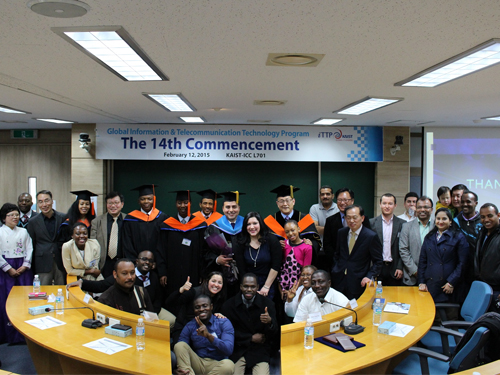 ITTP Produces 119 Graduates from 52 Countries.
“Transparency of Costa Rica was highly improved after adopting an electronic purchase and supply system from Korea.”
So noted a public official from the technical office of the digital government in Costa Rica, Ileana Palaco, who entered the master’s program in KAIST’s Global Information and Telecommunication Technology Program (ITTP) last September.
She also said, “The electronic government of Korea is an exemplary model emulated in the establishment of the e-Government system in Central and South America. I am eager to introduce Korean IT technology and policies to the countries in the region.”
Consisting of master’s and doctoral programs designed for public officials and technical experts in emerging countries, ITTP fosters international cooperation, builds human networks, and supports domestic companies in technology transfers.
For the past twenty years, the IT industry has been the key to Korea’s development. Utilizing its advancement in the IT technology, Korea provides developing countries with the support necessary for their continuous growth in the 21st century. To that end, KAIST created ITTP which invites government officials from emerging countries with a growing IT industry.
Run by the Business and Technology Management Department of KAIST since 2006, ITTP has produced 119 graduates from 52 countries. For the past 10 years, 57 students from Africa, 45 from South East-Asia, 16 from Eastern Europe, and 7 from the Middle East were accepted to the program.
The program consists of theory-based classes which introduces the technology and IT policies of Korea and project-based classes for university-industry cooperation. In the latter, experts from professional organizations in IT such as the Electronics and Telecommunications Research Institute (ETRI), the National Information Society Agency (NIA), and Korea Telecom participate and provide information based on industry experience.
Foreign governments and international organizations have reacted positively to this program. Having recognized its excellence, the International Telecommunication Union (ITU) has supported it by sending the application information to 193 member countries. The African Development Bank (AFDB) chose ITTP as one of the Next Generation African Leadership Programs and assigned 19 public officials from Africa.
ITTP graduates have played a large role in promoting the e-Government system overseas. In In 25 cases in 2012, graduates participated as researchers in 6 cases. Thanks to the support of elite public officials from emerging countries who graduated from ITTP, Korean technology companies can bring their technology to overseas countries more effectively.
Recently, government officials from these countries have been asking for both long and short- term programs on technology and IT policies. In response, KAIST is planning to expand the program. Professor Jaejeung Rho from the Business and Technology Management Department who supervises this program said, “Allowing public officials in the field of IT all over the world to know more about Korea is very important in raising Korea’s reputation in technology and in the globe” and added that “having these officials is a boon in keeping our country’s competitive edge in the IT industry.”
Picture: About 60 people including ITTP students, the Nigerian ambassador to Korea, and President Steve Kang of KAIST joined a ceremony to raise a scholarship fund for KAIST on April 2, 2015 at Munji campus in Daejeon.
2015.04.03 View 8457
ITTP Produces 119 Graduates from 52 Countries.
“Transparency of Costa Rica was highly improved after adopting an electronic purchase and supply system from Korea.”
So noted a public official from the technical office of the digital government in Costa Rica, Ileana Palaco, who entered the master’s program in KAIST’s Global Information and Telecommunication Technology Program (ITTP) last September.
She also said, “The electronic government of Korea is an exemplary model emulated in the establishment of the e-Government system in Central and South America. I am eager to introduce Korean IT technology and policies to the countries in the region.”
Consisting of master’s and doctoral programs designed for public officials and technical experts in emerging countries, ITTP fosters international cooperation, builds human networks, and supports domestic companies in technology transfers.
For the past twenty years, the IT industry has been the key to Korea’s development. Utilizing its advancement in the IT technology, Korea provides developing countries with the support necessary for their continuous growth in the 21st century. To that end, KAIST created ITTP which invites government officials from emerging countries with a growing IT industry.
Run by the Business and Technology Management Department of KAIST since 2006, ITTP has produced 119 graduates from 52 countries. For the past 10 years, 57 students from Africa, 45 from South East-Asia, 16 from Eastern Europe, and 7 from the Middle East were accepted to the program.
The program consists of theory-based classes which introduces the technology and IT policies of Korea and project-based classes for university-industry cooperation. In the latter, experts from professional organizations in IT such as the Electronics and Telecommunications Research Institute (ETRI), the National Information Society Agency (NIA), and Korea Telecom participate and provide information based on industry experience.
Foreign governments and international organizations have reacted positively to this program. Having recognized its excellence, the International Telecommunication Union (ITU) has supported it by sending the application information to 193 member countries. The African Development Bank (AFDB) chose ITTP as one of the Next Generation African Leadership Programs and assigned 19 public officials from Africa.
ITTP graduates have played a large role in promoting the e-Government system overseas. In In 25 cases in 2012, graduates participated as researchers in 6 cases. Thanks to the support of elite public officials from emerging countries who graduated from ITTP, Korean technology companies can bring their technology to overseas countries more effectively.
Recently, government officials from these countries have been asking for both long and short- term programs on technology and IT policies. In response, KAIST is planning to expand the program. Professor Jaejeung Rho from the Business and Technology Management Department who supervises this program said, “Allowing public officials in the field of IT all over the world to know more about Korea is very important in raising Korea’s reputation in technology and in the globe” and added that “having these officials is a boon in keeping our country’s competitive edge in the IT industry.”
Picture: About 60 people including ITTP students, the Nigerian ambassador to Korea, and President Steve Kang of KAIST joined a ceremony to raise a scholarship fund for KAIST on April 2, 2015 at Munji campus in Daejeon.
2015.04.03 View 8457 -
 KAIST Partners with Science-focused Universities in Korea for Student Exchange Programs
KAIST and four science-focused universities in Korea (Pohang University of Science and Technology, Gwangju Institute of Science and Technology, Daegu Gyeongbuk Institute of Science and Technology, and Ulsan National Institute of Science and Technology) agreed to exchange programs during academic semesters including summer and winter terms by signing a memorandum of understanding (MOU) on November 28, 2014. The signing ceremony took place at the KAIST campus with the participation of academic affairs deans from all five universities.
Based on the agreement, KAIST students can take up to 12 credits of coursework at any of the said universities and have unimpeded access to the university facilities during their coursework.
Dean Hyun-Wook Park of Academic Affairs at KASIT said, “Through exchange programs, students can capitalize on each university’s advantages, and this eventually will lead to greater advancement in science and technology in the nation.”
2014.12.08 View 8768
KAIST Partners with Science-focused Universities in Korea for Student Exchange Programs
KAIST and four science-focused universities in Korea (Pohang University of Science and Technology, Gwangju Institute of Science and Technology, Daegu Gyeongbuk Institute of Science and Technology, and Ulsan National Institute of Science and Technology) agreed to exchange programs during academic semesters including summer and winter terms by signing a memorandum of understanding (MOU) on November 28, 2014. The signing ceremony took place at the KAIST campus with the participation of academic affairs deans from all five universities.
Based on the agreement, KAIST students can take up to 12 credits of coursework at any of the said universities and have unimpeded access to the university facilities during their coursework.
Dean Hyun-Wook Park of Academic Affairs at KASIT said, “Through exchange programs, students can capitalize on each university’s advantages, and this eventually will lead to greater advancement in science and technology in the nation.”
2014.12.08 View 8768 -
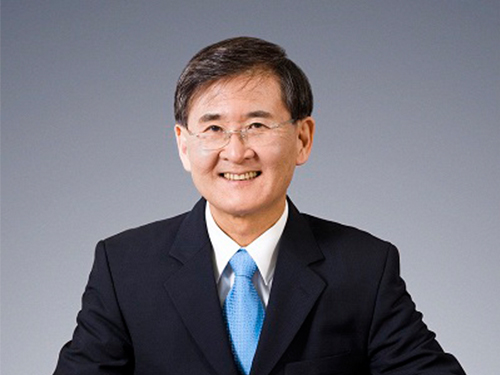 President of KAIST Becomes an International Board Member of Moscow Institute of Physics and Technology in Russia
President Sung-Mo “Steve” Kang of KAIST has been appointed a member of the International Board of the Moscow Institute of Physics and Technology (MIPT) in 2014, a leading Russian university specializing in theoretical and applied physics, mathematics, and related science and technology disciplines.
President Kang is the only scientist from Asia to become the latest member of the MIPT International Board. Consisting of 11 highly regarded scientists and scholars from all around the world, such as Professor Carlo Rubbia, a Nobel laureate in physics in 1984, President Alexander F. Andreev of the Kapitsa Institute for Physical Problems, President Ralph Eichler of the Zurich Federal Institute of Technology, and President Jaques Biot of the École Polytechnique Paris. Currently, President Leo Rafael Raif of MIT chairs the Board.
MIPT created the International Board (http://mipt.ru/en/about/general/international-board/) in 2013 to promote collaboration in international research and educational programs as well as to enhance its global visibility in the international community.
MIPT was established in 1946 by a group of prominent Soviet scientists including Pyotr Kapitsa, a Nobel laureate in physics in 1978, and was approved later in 1951 by the government of the former Soviet Union as a state university. Often referred as the “Russian MIT,” MIPT has earned international and domestic recognition through its unique educational system, providing students with opportunities for rigorous education in fundamental science and extensive research at leading research institutions of the Russian Academy of Sciences.
2014.09.28 View 7232
President of KAIST Becomes an International Board Member of Moscow Institute of Physics and Technology in Russia
President Sung-Mo “Steve” Kang of KAIST has been appointed a member of the International Board of the Moscow Institute of Physics and Technology (MIPT) in 2014, a leading Russian university specializing in theoretical and applied physics, mathematics, and related science and technology disciplines.
President Kang is the only scientist from Asia to become the latest member of the MIPT International Board. Consisting of 11 highly regarded scientists and scholars from all around the world, such as Professor Carlo Rubbia, a Nobel laureate in physics in 1984, President Alexander F. Andreev of the Kapitsa Institute for Physical Problems, President Ralph Eichler of the Zurich Federal Institute of Technology, and President Jaques Biot of the École Polytechnique Paris. Currently, President Leo Rafael Raif of MIT chairs the Board.
MIPT created the International Board (http://mipt.ru/en/about/general/international-board/) in 2013 to promote collaboration in international research and educational programs as well as to enhance its global visibility in the international community.
MIPT was established in 1946 by a group of prominent Soviet scientists including Pyotr Kapitsa, a Nobel laureate in physics in 1978, and was approved later in 1951 by the government of the former Soviet Union as a state university. Often referred as the “Russian MIT,” MIPT has earned international and domestic recognition through its unique educational system, providing students with opportunities for rigorous education in fundamental science and extensive research at leading research institutions of the Russian Academy of Sciences.
2014.09.28 View 7232 -
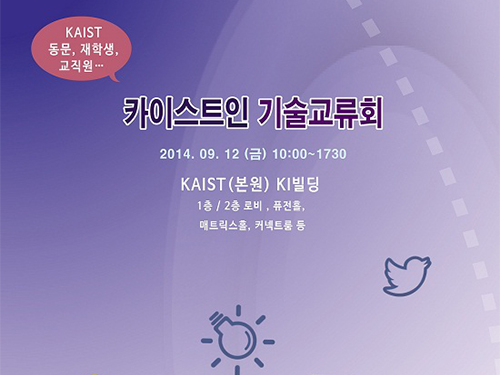 The Alumni Association of KAIST hosts the first KAIST Technology Exchange Meeting
The Alumni Association of KAIST hosted the first KAIST Technology Exchange Meeting on September 12th at the KAIST Institute on campus.
About 14 alumni companies, MDS Technology, Biospace, and Satrec Initiative, two private equity funds including KAIST Entrepreneurship Foundation, and KAIST Technology Commercialization Center participated in this meeting.
This meeting was organized by the Alumni Association of KAIST in order to strengthen cooperation between alumni companies and KAIST members by increasing technology exchange and fostering cooperative culture.
The meeting comprised of two sessions: product exhibition and technology-exchange session.
During the exhibition, participating companies prepared the following: product showcase, intellectual property exchange, project consulting, and employment information.
Companies involved in technology-exchange session not only showcased their brand new technology but also shared their innovative ideas and entrepreneur vision, and discussed joint R&D.
The president of the Alumni Association of KAIST, Man Kee Baek who was in charge of this meeting said, “I hope this meeting stimulates more technology exchange between alumni companies and school members.”
He added that “our alumni association will continue to organize many projects for better KAIST.”
Detailed information about the event can be found on the official webpage of the Alumni Association of KAIST (http://www.ilovekaist.net), and this event was open to the public.
A company specializing in medical devices, Biospace, plans to donate a body composition analyzer and an automatic blood pressure meter worth 14,000,000 won to KAIST.
2014.09.15 View 7312
The Alumni Association of KAIST hosts the first KAIST Technology Exchange Meeting
The Alumni Association of KAIST hosted the first KAIST Technology Exchange Meeting on September 12th at the KAIST Institute on campus.
About 14 alumni companies, MDS Technology, Biospace, and Satrec Initiative, two private equity funds including KAIST Entrepreneurship Foundation, and KAIST Technology Commercialization Center participated in this meeting.
This meeting was organized by the Alumni Association of KAIST in order to strengthen cooperation between alumni companies and KAIST members by increasing technology exchange and fostering cooperative culture.
The meeting comprised of two sessions: product exhibition and technology-exchange session.
During the exhibition, participating companies prepared the following: product showcase, intellectual property exchange, project consulting, and employment information.
Companies involved in technology-exchange session not only showcased their brand new technology but also shared their innovative ideas and entrepreneur vision, and discussed joint R&D.
The president of the Alumni Association of KAIST, Man Kee Baek who was in charge of this meeting said, “I hope this meeting stimulates more technology exchange between alumni companies and school members.”
He added that “our alumni association will continue to organize many projects for better KAIST.”
Detailed information about the event can be found on the official webpage of the Alumni Association of KAIST (http://www.ilovekaist.net), and this event was open to the public.
A company specializing in medical devices, Biospace, plans to donate a body composition analyzer and an automatic blood pressure meter worth 14,000,000 won to KAIST.
2014.09.15 View 7312 -
 KAIST's Advanced Biomass R&D Center and ToolGen will cooperate
The Advanced Biomass R&D Center (ABC) at KAIST and ToolGen, Inc., a Korean biotechnology company focused on the development of engineered nucleases that can be used as essential tools for editing genetic information in microbial, plant, animal, and human cells, signed a memorandum of understanding (MOU) on August 18, 2014 for technology exchange and research collaboration.
ABC is headed by Executive Director Ji-Won Yang, a professor emeritus at the Department of Chemical and Biomolecular Engineering, and Chief Executive Officer Jong-Moon Kim for ToolGen.
The newly signed MOU encourages collaborations in the following areas:
- Development of genome editing technology for microalgae modification
- Development of microalgae that increases biofuel production through the
application of genome editing technology
- Creation of education and training programs for researchers
- Collaboration in other areas
In addition, the two organizations decided to cooperate in the improvement of biofuel yields using ToolGen’s genome editing technology, the commercialization of research outcomes, and the development of eco-friendly biofuels from biomass.
Executive Director Yang commented that “improving biofuel production is crucial to accelerate the commercialization of biofuels, and collaborating with ToolGen will help us realize that goal.” He further said that “The importance of this MOU lies in the fact that the global chemical industry including Korea has been making substantial efforts to shift its attention from a fossil fuel-based development to a more bio-based technology.”
Jin-Soo Kim, the director of the Genome Editing Research Center at the Institute of Basic Sciences in Korea and the cofounder of ToolGen, added that “ToolGen has successfully commercialized its third generation genetic scissors, which shows a lot of promise for commercialization. Our collaboration with KAIST will serve as the driving force to create new industries and accordingly, new jobs.”
2014.09.03 View 11921
KAIST's Advanced Biomass R&D Center and ToolGen will cooperate
The Advanced Biomass R&D Center (ABC) at KAIST and ToolGen, Inc., a Korean biotechnology company focused on the development of engineered nucleases that can be used as essential tools for editing genetic information in microbial, plant, animal, and human cells, signed a memorandum of understanding (MOU) on August 18, 2014 for technology exchange and research collaboration.
ABC is headed by Executive Director Ji-Won Yang, a professor emeritus at the Department of Chemical and Biomolecular Engineering, and Chief Executive Officer Jong-Moon Kim for ToolGen.
The newly signed MOU encourages collaborations in the following areas:
- Development of genome editing technology for microalgae modification
- Development of microalgae that increases biofuel production through the
application of genome editing technology
- Creation of education and training programs for researchers
- Collaboration in other areas
In addition, the two organizations decided to cooperate in the improvement of biofuel yields using ToolGen’s genome editing technology, the commercialization of research outcomes, and the development of eco-friendly biofuels from biomass.
Executive Director Yang commented that “improving biofuel production is crucial to accelerate the commercialization of biofuels, and collaborating with ToolGen will help us realize that goal.” He further said that “The importance of this MOU lies in the fact that the global chemical industry including Korea has been making substantial efforts to shift its attention from a fossil fuel-based development to a more bio-based technology.”
Jin-Soo Kim, the director of the Genome Editing Research Center at the Institute of Basic Sciences in Korea and the cofounder of ToolGen, added that “ToolGen has successfully commercialized its third generation genetic scissors, which shows a lot of promise for commercialization. Our collaboration with KAIST will serve as the driving force to create new industries and accordingly, new jobs.”
2014.09.03 View 11921 -
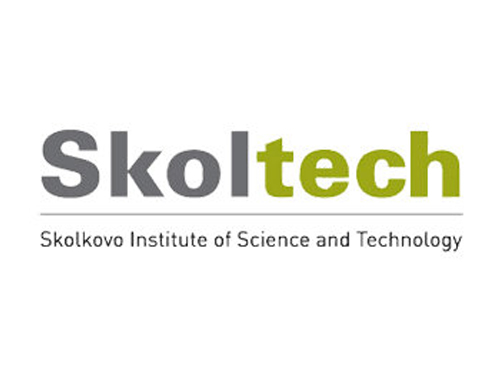 The MIT Skoltech Initiative Report identifies KAIST as one of the core group of emerging leaders for academic entrepreneurship and innovation
The Massachusetts Institute of Technology (MIT) Skoltech Initiative was established in 2011 to support MIT’s multi-year collaboration in building the Skolkovo Institute of Science and Technology (Skoltech), a private graduate research university in Skolkovo, Russia.
Recently, the office of the MIT Skoltech Initiative has published a benchmark report conducted from 2012 to 2014 by Dr. Ruth Graham, an internationally recognized leading consultant for engineering education and research as well as academic technology-driven entrepreneurship, under the guidance of MIT professors and the Center for Entrepreneurship and Innovation at the MIT Skoltech Initiative.
The report identified more than 200 institutions as the world’s most highly-regarded entrepreneurial universities and characterized the approach taken by them to build university-based ecosystems for entrepreneurship and innovation (E&I).
Among the top-ranked institutions, the report mentioned an emerging group of leaders (EGLs) that are “located within more challenging environments but establishing strong entrepreneurship and innovation profiles and reputations.” The report named, in particular, five universities, KAIST (Korea), Technion (Israel), Aalto University (Finland), the University of Michigan (US), and the University of Auckland (NZ), as the core group of the EGLs.
This benchmarking study was written to highlight key strategies and features associated with well-regarded university E&I transformations within more challenging environments and to address barriers and limits faced by the EGLs, thereby providing a good model to other universities wishing to make similar changes.
Through an in-depth case study of a small group of emerging universities, the report concluded that three major components play a critical role in the development of institutional E&I capacity and the growth of ecosystems for E&I:
Component 1: Inclusive grassroots community of E&I engagement across university populations and regional community;
Component 2: Strength in industry-funded research and licensing of university-owned technology; and
Component 3: University E&I agenda reflected in its policies, mission, budget allocations, incentives and curriculum
For more details, please visit the link below:
http://web.mit.edu/sktech/sktech-program/entrepreneurship-innovation/benchmark.html
2014.08.20 View 9553
The MIT Skoltech Initiative Report identifies KAIST as one of the core group of emerging leaders for academic entrepreneurship and innovation
The Massachusetts Institute of Technology (MIT) Skoltech Initiative was established in 2011 to support MIT’s multi-year collaboration in building the Skolkovo Institute of Science and Technology (Skoltech), a private graduate research university in Skolkovo, Russia.
Recently, the office of the MIT Skoltech Initiative has published a benchmark report conducted from 2012 to 2014 by Dr. Ruth Graham, an internationally recognized leading consultant for engineering education and research as well as academic technology-driven entrepreneurship, under the guidance of MIT professors and the Center for Entrepreneurship and Innovation at the MIT Skoltech Initiative.
The report identified more than 200 institutions as the world’s most highly-regarded entrepreneurial universities and characterized the approach taken by them to build university-based ecosystems for entrepreneurship and innovation (E&I).
Among the top-ranked institutions, the report mentioned an emerging group of leaders (EGLs) that are “located within more challenging environments but establishing strong entrepreneurship and innovation profiles and reputations.” The report named, in particular, five universities, KAIST (Korea), Technion (Israel), Aalto University (Finland), the University of Michigan (US), and the University of Auckland (NZ), as the core group of the EGLs.
This benchmarking study was written to highlight key strategies and features associated with well-regarded university E&I transformations within more challenging environments and to address barriers and limits faced by the EGLs, thereby providing a good model to other universities wishing to make similar changes.
Through an in-depth case study of a small group of emerging universities, the report concluded that three major components play a critical role in the development of institutional E&I capacity and the growth of ecosystems for E&I:
Component 1: Inclusive grassroots community of E&I engagement across university populations and regional community;
Component 2: Strength in industry-funded research and licensing of university-owned technology; and
Component 3: University E&I agenda reflected in its policies, mission, budget allocations, incentives and curriculum
For more details, please visit the link below:
http://web.mit.edu/sktech/sktech-program/entrepreneurship-innovation/benchmark.html
2014.08.20 View 9553 -
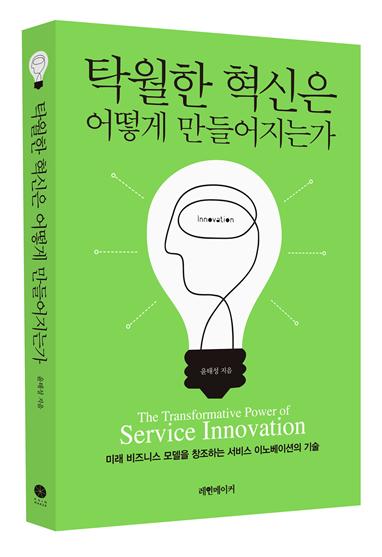 Book Announcement: The Transformative Power of Service Innovation
Professor
Tae-Sung Yoon of the Technology Management Graduate School at KAIST has
recently published a book entitled
The
Transformative Power of Service Innovation
(available only in Korean).
In the
book, Professor Yoon presents many examples of successful service innovations
and explores the topic of how excellence in innovation can be achieved through the
convergence of diverse fields and industries.
2014.04.01 View 8481
Book Announcement: The Transformative Power of Service Innovation
Professor
Tae-Sung Yoon of the Technology Management Graduate School at KAIST has
recently published a book entitled
The
Transformative Power of Service Innovation
(available only in Korean).
In the
book, Professor Yoon presents many examples of successful service innovations
and explores the topic of how excellence in innovation can be achieved through the
convergence of diverse fields and industries.
2014.04.01 View 8481 -
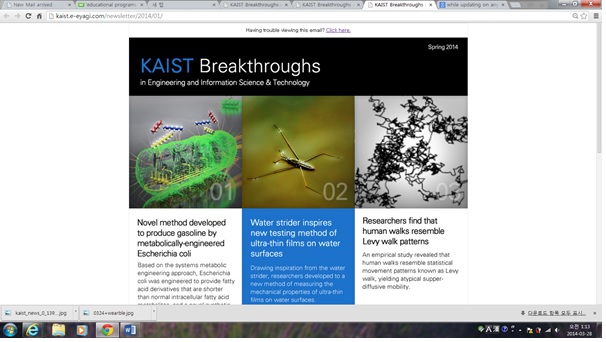 Newsletter: KAIST Breakthroughs in Engineering and Information Science & Technology
The
College of Engineering and the College of Information Science & Technology
at KAIST jointly published a bi-annual online newsletter, KAIST Breakthroughs in Engineering and Information Science &
Technology. The newsletter highlights major research achievements of the
two colleges while updating readers on any news or developments in their educational
programs.
For
the spring issue of the newsletter, please go to:
http://kaist.e-eyagi.com/newsletter/2014/01/
2014.03.28 View 7636
Newsletter: KAIST Breakthroughs in Engineering and Information Science & Technology
The
College of Engineering and the College of Information Science & Technology
at KAIST jointly published a bi-annual online newsletter, KAIST Breakthroughs in Engineering and Information Science &
Technology. The newsletter highlights major research achievements of the
two colleges while updating readers on any news or developments in their educational
programs.
For
the spring issue of the newsletter, please go to:
http://kaist.e-eyagi.com/newsletter/2014/01/
2014.03.28 View 7636 -
 ACM Interactions: Demo Hour, March and April 2014 Issue
The
Association for Computing Machinery (ACM), the largest educational and scientific
computing society in the world, publishes a magazine called
Interactions
bi-monthly.
Interactions
is the flagship magazine
for the ACM’s Special Interest Group on Computer-Human Interaction (SIGCHI) with
a global circulation that includes all SIGCHI members.
In
its March and April 2014 issue, the Smart E-book was introduced. It was developed by Sangtae Kim, Jaejeung
Kim, and Soobin Lee at the Information Technology Convergence in KAIST
Institute, KAIST.
For
the article, please go to the link or download the .pdf files below:
Interactions,
March &
April 2014
Demo Hour: Bezel-Flipper
Bezel-Flipper
Interactions_Mar & Apr 2014.pdf
http://interactions.acm.org/archive/view/march-april-2014/demo-hour29
2014.03.28 View 11866
ACM Interactions: Demo Hour, March and April 2014 Issue
The
Association for Computing Machinery (ACM), the largest educational and scientific
computing society in the world, publishes a magazine called
Interactions
bi-monthly.
Interactions
is the flagship magazine
for the ACM’s Special Interest Group on Computer-Human Interaction (SIGCHI) with
a global circulation that includes all SIGCHI members.
In
its March and April 2014 issue, the Smart E-book was introduced. It was developed by Sangtae Kim, Jaejeung
Kim, and Soobin Lee at the Information Technology Convergence in KAIST
Institute, KAIST.
For
the article, please go to the link or download the .pdf files below:
Interactions,
March &
April 2014
Demo Hour: Bezel-Flipper
Bezel-Flipper
Interactions_Mar & Apr 2014.pdf
http://interactions.acm.org/archive/view/march-april-2014/demo-hour29
2014.03.28 View 11866 -
 Former Minister of Science and Technology, Dr. KunMo Chung, Awarded KAIST Honorary Doctorate
KAIST will confer an honorary doctorate on former minister of Science and Technology, Dr. KunMo Chung, at the 2014 KAIST graduation ceremony on Friday, February, 21.Dr. Chung presented the Survey Report for the Establishment of the Korea Advanced Institute of Science (KAIS) to the United States Agency for International Development (USAID) in 1969. This proposal for nurturing the advanced science technology elite and boost Korean industrial development became the foundation for KAIS, which is now known as KAIST.After passing the KAIS Foundation Law in 1970, Dr. Chung designed the faculty room, secured faculty members, and acquired a $6 million education loan from the USAID. Dr. Chung devoted himself to research and teaching. His first appointment was the position of assistant professor at the University of South Florida, followed by research professor positions at the Princeton Nuclear Fusion Research Center and MIT Nuclear Engineering, and an associate professor position in the Department of Electrophysics at the Polytechnic Institute of New York.When KAIS was founded on Feb. 16, 1971, 31-year-old Dr. KunMo Chung became the provost and a professor in the Electronic and Electrical Science Department where he made outstanding contributions to the development of science and technology in Korea.
2014.02.21 View 11664
Former Minister of Science and Technology, Dr. KunMo Chung, Awarded KAIST Honorary Doctorate
KAIST will confer an honorary doctorate on former minister of Science and Technology, Dr. KunMo Chung, at the 2014 KAIST graduation ceremony on Friday, February, 21.Dr. Chung presented the Survey Report for the Establishment of the Korea Advanced Institute of Science (KAIS) to the United States Agency for International Development (USAID) in 1969. This proposal for nurturing the advanced science technology elite and boost Korean industrial development became the foundation for KAIS, which is now known as KAIST.After passing the KAIS Foundation Law in 1970, Dr. Chung designed the faculty room, secured faculty members, and acquired a $6 million education loan from the USAID. Dr. Chung devoted himself to research and teaching. His first appointment was the position of assistant professor at the University of South Florida, followed by research professor positions at the Princeton Nuclear Fusion Research Center and MIT Nuclear Engineering, and an associate professor position in the Department of Electrophysics at the Polytechnic Institute of New York.When KAIS was founded on Feb. 16, 1971, 31-year-old Dr. KunMo Chung became the provost and a professor in the Electronic and Electrical Science Department where he made outstanding contributions to the development of science and technology in Korea.
2014.02.21 View 11664